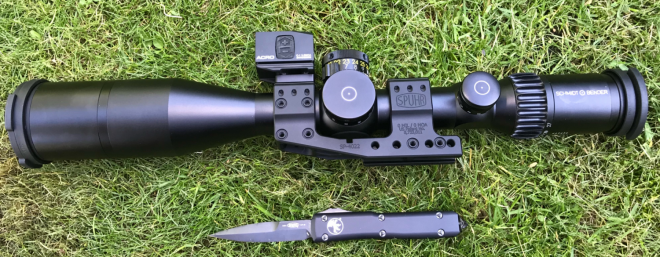The Firearm Blog continues its mission of reviewing as many of the Schmidt & Bender PM II Riflescopes as possible. Previously we had a look at the top-seller S&B 5-25×56 PM II and the S&B 1-8×24 PM II ShortDot Dual CC, one of the few riflescopes with reticles in both planes. In this review, we’re going to take a closer look at the 3-27×56 PMII, a High Power version with an impressive 9 power magnification range. TFB’s “system” also includes a Spuhr mount and the Aimpoint ACRO C-1 red dot.

Schmidt & Bender 3-27×56 PMII with optional sunshade, Aimpoint ACRO C-1 and Spuhr SP-4022. Microtech Ultratech bayonet.
When USSOCOM (United States Special Operations Command) set up their requirements for a new Extreme Long Range Dayscope, Schmidt & Bender responded by combining the features of the 5-25×56 PMII and the 3-20x50PMII.
Together with the 5-45×56 PM II, the 3-27×56 model is the top-of-the-line from Schmidt & Bender. The 9 power zoom causes a big deal of the costs for this scope. The optical design is demanding and there are a lot of high-performing lenses which have to be adjusted in perfect alignment by S&B’s technicians.
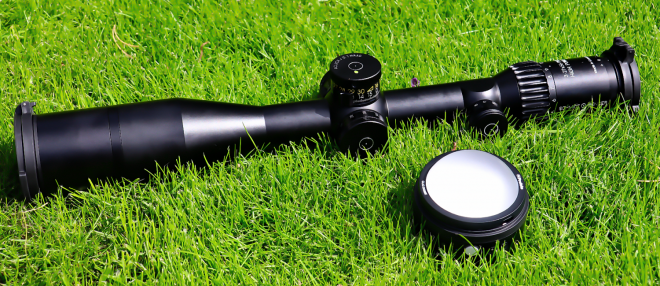
Development Background of the PMII long-range scopes:
As the fields of applications started becoming more diverse and the shooting distances longer, the need for more versatile tactical rifle scopes became obvious. From these requirements, the PMII (Police Marksman) long-range series was born, with the 3-12×50 PMII scope as the first “baby”.
The 3-12×50 PMII proved its reliability in various applications and was developed into a special edition for the U.S. Marine Corps. They are, however, far from the only Military or Police force that use it. I have been using mine for PRS-style shooting, and you’d be amazed how far you can reach out with confirmed hits (900 meters with a .308 Win rifle in my case).

Then came the 4-16×50 PMII for shooting distances beyond 1000 meters, which was also adopted by the U.S. Army.
The next development was the 5-25×56 PMII which is probably S&B’s most famous scope, and a benchmark for others. TFB has an extended review of this scope here. It was chosen by the US Special Operations Command (Navy, Army, Marines and Air Force) as the ideal scope for the Precision Sniper Rifle Program.
There was a gap between the 3-12×50 PMII and the 5-25×56 PMII, so S&B developed the 3-20x50PMII for medium to long-range distances. I guess you can see where the next development was going now?

The Scope: Schmidt & Bender 3-27×56 PM II High Power
USSOCOM set up a long list of Key Performance Parameters and S&B responded with the 3-27×56 PMII. A design that complied to or exceeded all of the requirements. The request was a magnification power that started at 3x to 5x minimum, and up to 20x-30x maximum. Design-wise, the 3-27×56 keeps a combination of the advantages of the 5-25×56 PMII and the 3-20×50 PMII. USSOCOM’s request was for a Horus H58 Reticle, with future plans for Tremor 2. The scope tested here has the GR²ID reticle, but there are several other first focal plane reticle options.
Ergonomics
The overall length is 394 mm, or 15.55″. Note that in some of the pictures, the scope has an optional sunshade in the front, adding another 50 mm (~2″) and making it look bigger than it is. The tube is 34 mm so you have a wide range of mounts that should fit. The eyepiece’s optical diameter is 42.1 mm while the mechanical diameter of the eyepiece housing is 50 mm. The objective diameter is 56 mm and the total weight is 1,128 g (2.48 pounds).
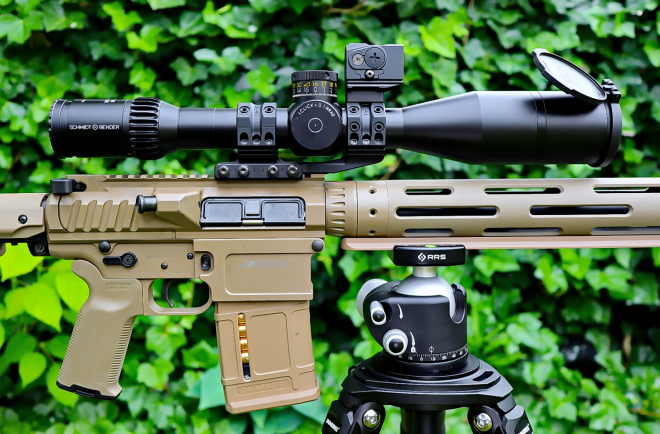
It’s a fairly large scope, but it will probably blend in just fine on most of the rifle systems that it will be fitted to. There’s nothing unnecessary in the design, and it’s easy to find and use all of the controls. If you don’t like these turrets, there are many options.

The magnification control is machined aluminium with deep serrations for a good grip, without being too aggressive. The design is the same as the 3-20×50 PMII, so is the diopter ring. In this review, we added the metal S&B Throw Lever (p/n 971-06840) to get some more torque (and so should you). The movement is silent and you can’t sense any internal movement of the mechanics.
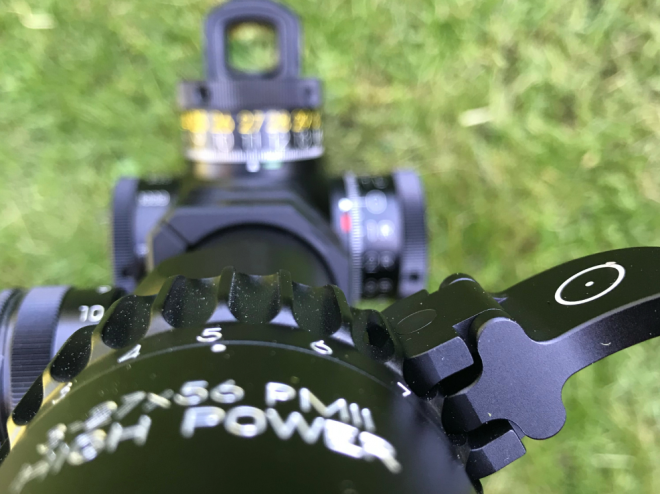
The eye relief is 90 mm (3.5″) and the exit pupil on the highest magnification is 2.1mm. The parallax adjustment runs smooth and the range reaches from 10 meters to infinity, just as on the 5-25×56 PMII. To evaluate the parallax I tried to move my head to check for reticle movement, but it seems to work well.
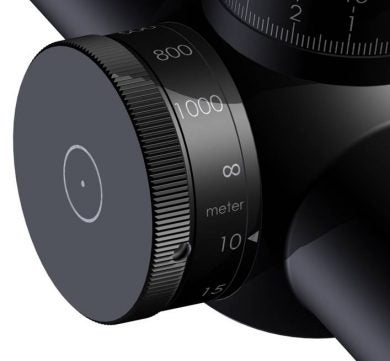
From the Schmidt & Bender White Papers to USSOCOM
The illumination knob is designed in the same way as all other PMII scopes and runs from 0 to 11 with no off positions in-between. If the illumination is not switched off by the shooter (happens to me all the time), the electronics will automatically switch off after 6 hours, saving some battery.
The tested scope was standard black, but you can also order Pantone 7504M or RAL 8000.
Below: As they are priced at a similar level, I am sure that people would compare the 3-27 to the 5-45×56 PMII. Here you can see the size and design differences. You don’t see these side-by-side too often.

In terms of prices, the 3-27 starts from 4,042 EUR net and the 5-45 from 4,092 EUR net. Note that prices in other markets may vary, but it works as a reference. The warranty is 2 years.
You can also order a polarization filter, something I plan to do in the future. This new kind of polarization filter can be screwed easily into the ocular, making it possible to see through glass. For certain snipers this may be quite useful, but it should also work well on reflections in the grass (that’s what I plan to find out). The filter is available for the models: High Power, Ultra Short and the 1-8×24 PM II ShortDot Dual CC.
To protect the scope I added S&B’s new “Tactical Bag” in Coyote. The end corners are flexible, so if you have added your own configuration like secondary sights, laser range finders etc, you can protect these as well. The price for the bag was €75 net, and it doubles as a carrying handle. Quality and attention to detail was high.
The Turret (DoubleTurn II+ MTC LT / ST II ZC LT)
The turret is as important to the sniper as the keyboard is to an author, and who likes shooting errors or spelling mistakes?
This scope has the new Double Turn II+ turret, which has a relatively low and flat design with a tactile turn indicator that can be seen and felt as you transition through to the second turn.
I’m happy to say that the new turrets are the best I have ever tried, even from S&B. It’s easy to do your clicking without looking at the turret. You can both hear and feel each click (1/10 Mil) and every 10th click (1 Mil) is different or more tactile. This could be essential in low-light conditions.

With a lever, you can also lock the turret completely to prevent unintentional rotations. There are three lever settings to choose from. Locked, represented by a red color in a small window next to the index marking. In the second mode, you have a green in the display, and you get the MTC function described above (More Tactile Click) as usual. The third mode deactivates the MTC, which is indicated by a black viewing window. Here you get your traditional clicks back.
Below: Note green window (top turret) and red window (windage).

Clicks are either 1/10 Mil or ¼ MOA, with a 305 cm / 30.5 MRAD or 77 MOA elevation, clockwise or counter-clockwise depending on your choice. If that internal elevation range isn’t enough S&B also has a turret with 34 MIL, but this turret is the older generation of MTC/LT. The windage turret has a zero tactile click, and can also be locked and gives you a red visual indication of this. During the testing, there were no issues with tracking.
For the record, the scope tested here has the following S&B code: (669-911-422-M3-I6) 3-27×56 PM II High Power LP. GR²ID 1cm cw DT II+ MTC LT / ST II ZC LT.
Below: From S&B’s 2020 US brochure. Note how cluttered the Tremor and Grid reticle look when compressed.

The Eyebox
The eyepiece provides adjustment of the reticle focus to the individual eye diopter. Find a stable shooting (spotting) position. Then you set the scope to the highest magnification, and rotate the eyepiece counter-clockwise until it stops. Start rotating the eyepiece clockwise until you see a sharp and perfect image of the reticle.

As explained in previous articles, think of the eyebox as a volume outside the scope, where you can keep your eye and still be able to see the target and shoot. Think of the volume as looking a bit like an American football. The larger the volume (“working area”), the more forgiving the scope will be to shoot. The larger the magnification, the smaller the eyebox will become. Hence at 27 power, you’re going to have to stay very still, in the exact position. I would say that the eyebox is less forgiving on the 3-27 than on the 5-25, but if you’re in the right shooting position you won’t really notice this. For a deeper explanation of the eyebox, you can check this video (Understanding Eye Box, and More, with Leupold).
True 27x Power or Not?
Before we explain the reticle used in this scope, I want to add that I had heard from a few sources that the 3-27 was not a true 27 at full power. This is quite hard to measure and prove so until TFB gets our own optical laboratory we won’t know for sure. However, on one occasion, we had a Vortex Razor HD Gen II 4.5-27×56 for some side-to-side testing, and with the S&B 3-27 set on 4.5 and 27 power we could see exactly the same width at 300 meters. Enough proof for me.
The GR²ID Reticle
The GR²ID ballistic grid was designed by Robert Ramsden from South Africa, together with international Precision Rifle Competitors. The R² comes from his initials. The aim was to provide information so that the shooter can determine the elevation and windage. Yet the grid should remain ‘uncluttered’ and easy to see ‘through’, like a heads-up display.
When there’s a lot of wind, I find it difficult to aim in a traditional reticle that provides a “non-visible grid”. To make corrections or calling my shot is even more difficult, therefore I was really interested in trying out the GR²ID and so far it has worked well for me.
Below: S&B 3-27×56 PMII at low power. At 3x magnification, you get a field of view of 13 m at 100 meters. This is better for observation than target shooting.
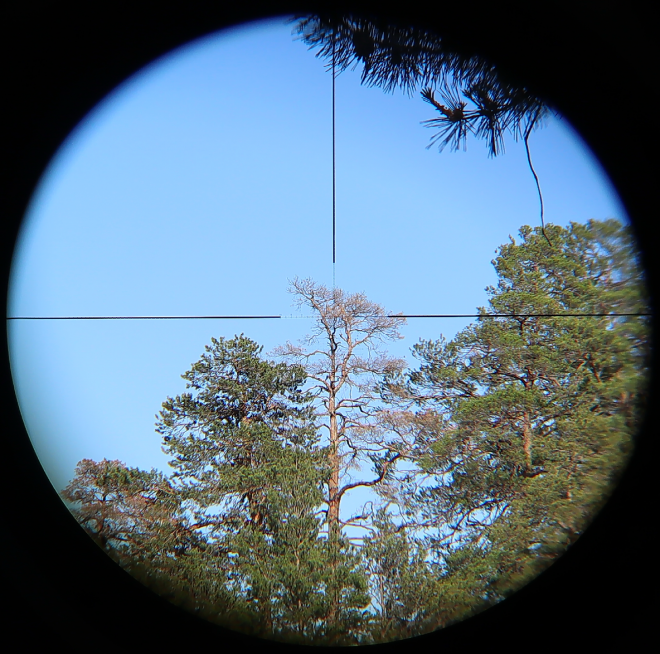
Putting the magnification at work. Please note that it is really hard to take accurate pictures that represent what the original viewer sees and experiences. I would say that the first-hand experience is always much better in person, but pictures like these are the only substitute we can offer to actually being behind the scope.
Below: S&B 3-27×56 PMII at full 27 times magnification. Distance – about 180 meters.

To compare, we had the 5-45 handy as well.
Below: S&B 5-45×56 PMII at full 45 times magnification. Distance – about 180 meters.
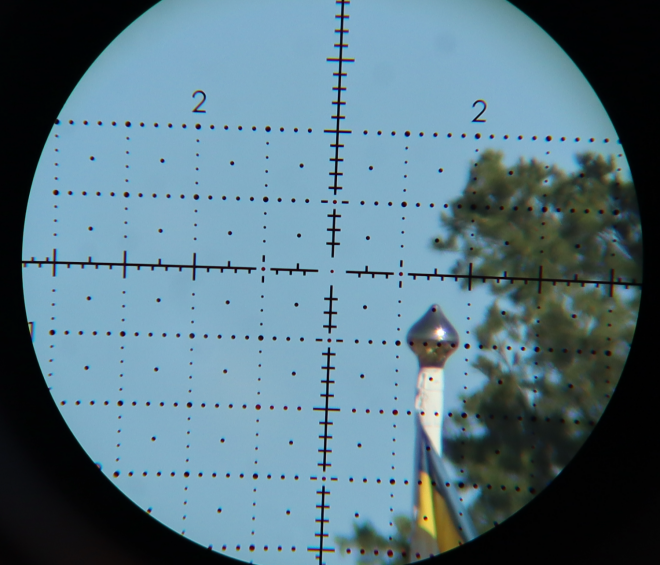
Note: S&B 5-45×56 PMII
Below: S&B 3-27×56 PMII at full 27 times magnification. Remember that the Art of ”taking photos through optics” is a difficult one.

Below: S&B 5-45×56 PMII at full 45 times magnification. The illumination is on, but the camera has difficulties to capture it in daylight. You can notice that some of the dots are red. There is no flare or reflections from the diode.

Note: S&B 5-45×56 PMII
There are four areas of design in the GR²ID: the Base Reticle, the Ballistic Grid, the Hold Over/Under Grid and the Illumination Tree.
The Hold Over/Under Grid came about from the wish of Practical Precision Rifle Competitors to dial out the elevation and windage of a mid-range target in order to then use the reticle to either hold over or under as they engage multiple targets at different distances in a stage.
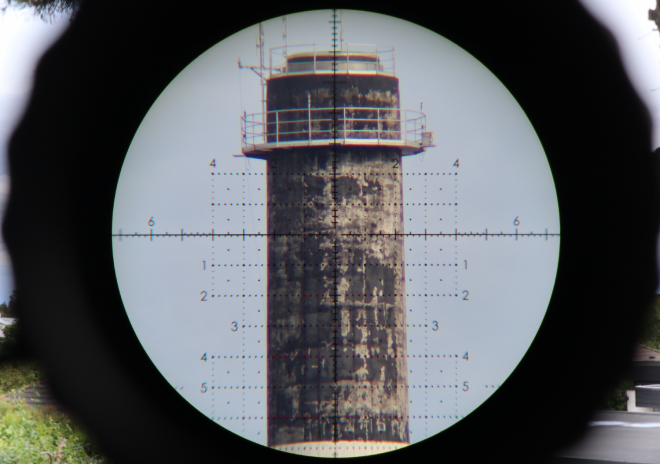
Below: Here you can see the illumination.
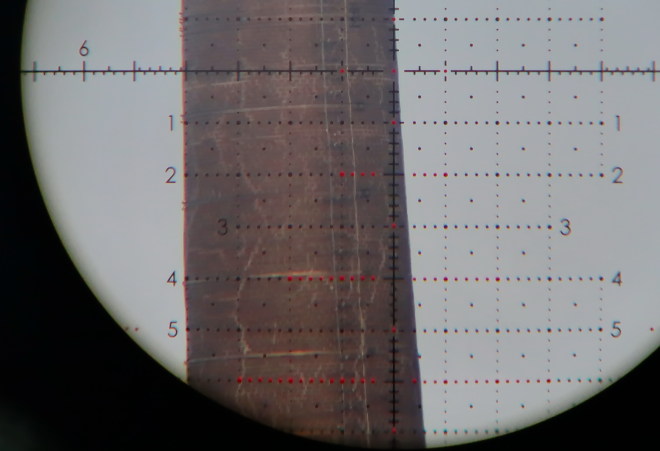
If there’s less to dial and remember under stress, you might get more hits and faster stage time.
There are elevation numbers provided in 1 Mil increments on both sides of the grid, to help you with the “where am I?”

Distance: 1250 meters.
Below: The Ballistic Grid features a horizontal dot pattern with 0.06 Mil dots (B) every 0.2 Mil and larger 0.08 Mil dots (C) at the 1 Mil markers to aid in line identification. The vertical dot pattern has unobtrusive 0.04 Mil dots (D). The center dot is 0.5 cm/100m or 0.18 in/100yd (A). Small but not silly small.
Note that this is the “CAD” image of the reticle. In reality, the dots and the grid appear much less cluttered.

The grid has been designed to cover the ballistics of a 308 Win (175-grain bullet at 2,580 fps) in
a full value 25 mph crosswind out to 900 meters. If you’re shooting more efficient calibers the grid will extend past 1,100 meters.
The illuminated reticle is designed to help to identify the correct aiming point on a dark target and/or in poor light conditions. The illumination is not really daylight bright, but it depends largely on the background.

According to the designer, the reticle works best at around 15 power magnification. Another good reticle choice for the 3-27 would be the MRS2 or the LRR-MIL.
The GR²ID reticle suits my shooting style, but I need more time and experience behind it to be able to use the system to its full extent. One thing on my wish list would be a brighter daylight illumination, but also for a better battery life. How typical of customers to ask for contradictory things!
Here is a short video by S&B.
The Company
Schmidt & Bender (Germany) is a family operated business since 1957, where you will find values like quality, precision, tradition and innovation. Their sole business is to manufacture high-quality rifle scopes. The warranty is 2 years which may be similar or less than others, but it feels like a quality purchase from people who do their thing really well. I never had to service an S&B, but I had use of their service department for reticle changes and it has worked well.
The Secondary Sight – Aimpoint ACRO C-1 3.5 MOA
The flat design of the DTII+ turret allows you to attach a secondary sight, like a red dot. I would much rather have my secondary sight in the 12 o’clock position than anywhere else. With a 10 mm Spuhr spacer, you achieve a full view through the turret without obscuring anything. In this case, I chose the Aimpoint ACRO C-1 3.5 MOA. As the red dot’s position on any rifle is quite exposed I want something that I know will last. The Aimpoint Micro is fine, but the ACRO is newer and smaller. We did a review of one of the first ACRO P-1s here.

The way I use it is that I look for the target with both eyes open, looking through the ACRO red dot. When I am in the vicinity I let my strong eye sink into the scope with (hopefully) a perfect magnified picture of the target in the reticle to make my shot. This saves a lot of time, and I never look in the grass with 20+ power trying to find my target.

If you want to copy this setup, the part number for the Spuhr spacer is A-0015 10 mm Spacer and A-0055 for the ACRO P-1 Interface.
The only drawback with this setup is that it will be more difficult to put the lever on the turret in or out of the locked position, but since I rarely lock my turrets it’s not a big issue. There is also some front-protection for the turret from the installation itself.
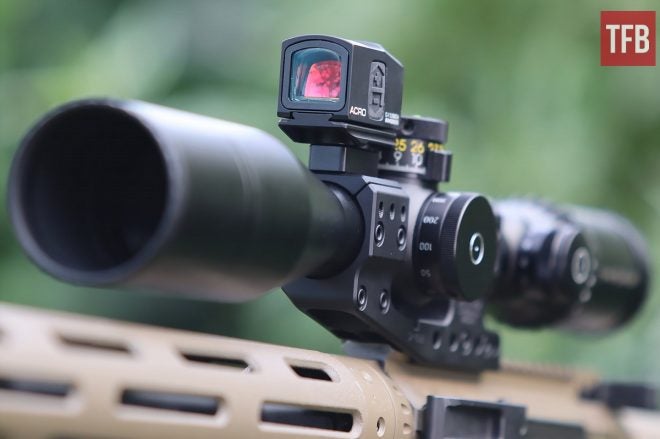
What about the battery life you ask? I have two Aimpoint ACRO C-1s. When I got the first, last year, I turned it on, and left it on one of the higher illumination settings (not the highest as it is too bright to use in most cases anyway) and the dot is still on. The only comparison I have is that I purchased another red dot for my PCC, made by another quality manufacturer, and I had to change the battery last week. The illumination setting was on a similar level as the ACRO.
Testing Platform
JP Enterprises PCS-12 in Magpul Dark Earth. This rifle was born and baptized as a 308 Win, but now identifies as a 6.5 Creedmoor. It enjoys life much better now as it provides hits to its owner with greater accuracy than ever, and very much liked the crowning by one of S&B’s mightiest scopes.in
The suppressor is from Swiss B&T and the cover is a custom HTP from Cole-Tac. The cover does an excellent job at hiding the heat and reducing the mirage from the suppressor. The 308 magazine is from Oberland Arms. The pistol grip is a Magpul K2+, so is the extra ARCA rail (Cerakoted). The JP PCS-12 has both a normal charging handle (upgrade to a Raptor) and a side-charger, and it’s a beast.

The tripod above is the model RT90C from Innorel and the BH-55 ball head is from RRS Really Right Stuff. A great way of combining cheap and expensive, made in China and Made in USA. These will be reviewed separately, but the system works great.

With and without the extra sun-shade. What do you prefer?
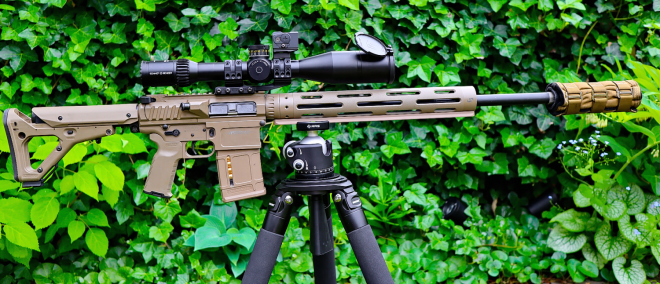
The Spuhr Mount SP-4022
The name of the mount is SP-4022 Ø34 H38mm/1.5” 0MIL. It has an MSRP of €309.
This mount is a combination of the extended cantilever of the SP-4026 and the absolute co-witness of the SP-4016. It is based on the 3GUN competition mount designed for The Noveske Shooting Team.
As the scope is rather long and was going on an AR-10 with limited Picatinny rail, this mount allows the scope to be mounted 70 mm /2.76” further forward than with a non-cantilever mount.

Due to the extreme cantilever, the SP-4022 does not feature a bubble level like the rest of the mounts in the Spuhr ISMS series.
The mount is machined from billet 7075 T651 aluminum and is hard coat anodized. The Torx 20 ring and clamping screws are zinc-nickel coated for corrosion resistance.
The rings are diagonally cut for increased visibility of the S&B parallax and windage turrets and the Spuhr interface allows you to attach more than 40 different accessories whatever they may be.

As usual there’s a 10-degree wedge included to line up your scope. Total weight of the mount is 246 g/8.7 oz.
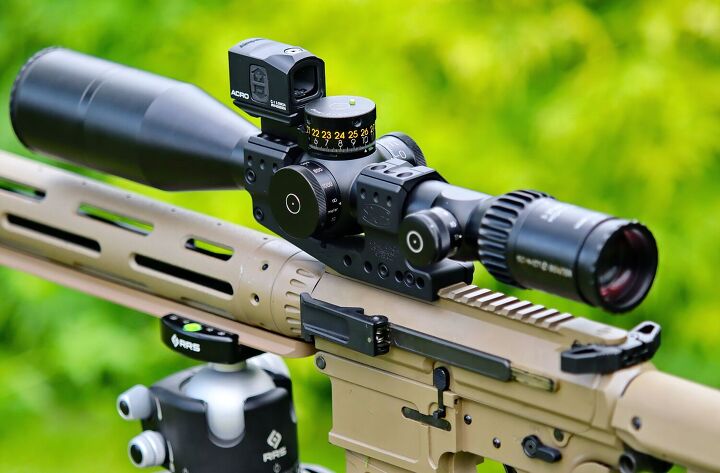
This is a great, zero-issues, mount. The possibilities to mount your own accessories where you want them are almost endless, but most importantly it keeps the zero. I have tried this with several different optics and Spuhr mounts, mounting things on and off. Spuhr may not be the cheapest on the market, but if I have to spend time and ammo to check the zero that’s a cost as well.
Below: Muzzle up, range is queer? Pride in sniping? Rainbow Warrior? There are lots of jokes to tell, but when you have the rainbow in sight, you take the opportunity.
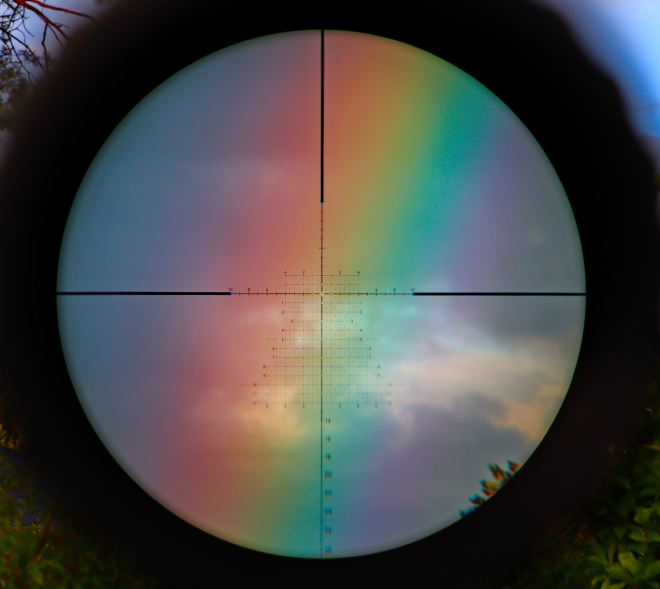
Conclusion
Quality 25-ish power scopes are the new black, and they come in all quality and price levels. But how often do you shoot with a magnifications over 20? In the type of sports shooting and competitions I participate in, the answer is a lot, and probably more than I should.
When I look side-by-side I think the S&B 3-27 has an optical advantage over the older brother 5-25 PMII. All optics are, however, a compromise and the price is a little less forgiving eyebox and a parallax that needs some more attention. However the eye relief is consistent through the full magnification range in both scopes, so this isn’t much of an issue.
The optical quality is incredible, with a very crisp image and a sharp reticle. There is no tunneling and as you can perhaps see from the selection of my through-the-lens images, I find the top-end really useful.
Below: We tested the S&B 3-27 on a modified Ruger Precision Rifle as well (.308 Win). After zeroing there were no issues in shooting bullseye 10/10 hits with GGG 168 grain SMK ammunition. Apart from using the maximum 27 power (”because we can”), we also shot groups at 16 power, the sweet spot for the reticle according to the designer, with the same result at 300 meters.
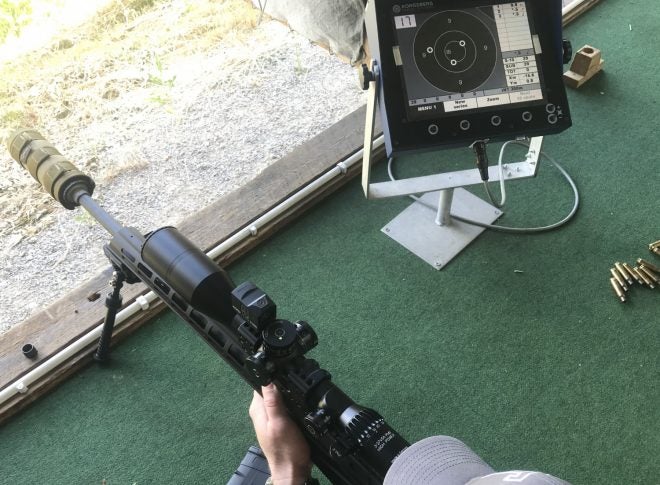
I use the low power magnifications very seldom, but it’s nice to be able to have a combination of a low-end 3x magnification for a wonderful field of view with a very high 27x top-end magnification for long range shooting. And remember, the people who specified the 3 power probably have a great use of it, especially on an AR-platform. You can only miss what you don’t have…and I’d rather have power 3 than 5 as my lowest option for magnification.

Note the Aimpoint ACRO, used more as a rough aiming device than a secondary sight in most cases.
Below: S&B 3-27×56 PMII at full 27 times magnification. The distance is about 1,280 meters (4,200 feet). I am still fine-tuning my setup to take better reticle images. This was taken in a fixture with a Canon EOS M50, and the lens has some difficulties to capture how sharp the reticle is.

For comparing reticle images on the same chimney, check our review of the Zero Compromise ZC527.
Someone told me they would never consider the 3-27 as the 5-45 comes at the same price. It seemed logical then, but when I have them side-by-side I’m not so sure anymore. The 3-27 range is really a Kinder Egg, with a lot of wishes fulfilled in one package. When you crank the 5-45 past 35 it’s just so much magnification, it’s insane, but we will have a closer look at that in an upcoming review.
If you’re looking for a Schmidt & Bender and the price isn’t your first priority, the sweet spot is most likely the 3-27. Otherwise, perhaps you can find a 5-25 on a discount to step into the World of German Optics?
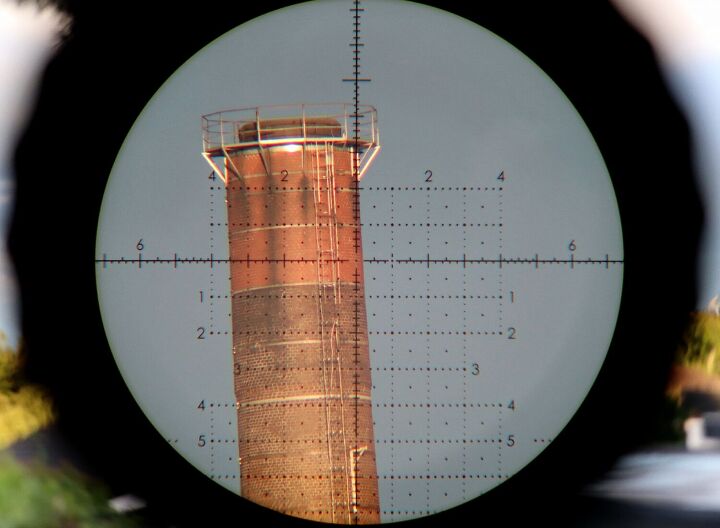
Many thanks to Schmidt & Bender Germany and Spuhr Sweden for letting us borrow these high-end products. We can never test everything and every aspect, but hopefully, this article can help you make an educated purchase.
Finally, here’s a link to the S&B product page.
We are committed to finding, researching, and recommending the best products. We earn commissions from purchases you make using the retail links in our product reviews. Learn more about how this works.
Source link

